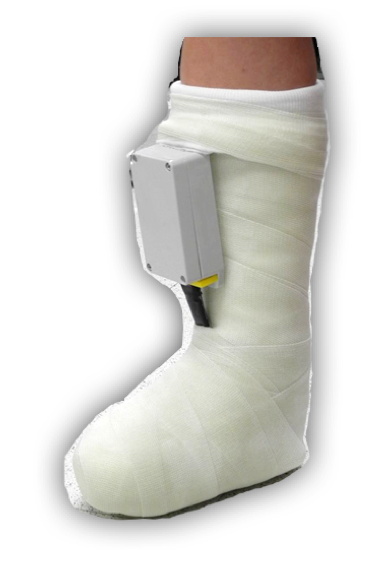Home » News » VISE Supports Medical Projects that Directly Impact Patients
VISE Supports Medical Projects that Directly Impact Patients
Posted by anderc8 on Tuesday, May 9, 2017 in News, TIPs 2015.

Written by John Mendoza, B.E. Biomedical Engineering 2016, M.S. Biomedical Engineering 2017

A previous design iteration showing the light & power source unit above with fiber optics leading out to a small silicone halo.
Vanderbilt Institute for Surgery and Engineering (VISE) is a prime example of one of the university’s invaluable resources available to engineering students looking to hit the ground running. Because it lies at the university’s forefront of surgical excellence and engineering solutions, VISE understands the importance of early support for medical projects that directly impact patients. After discussing options with our academic advisor, Matthew Walker III, Ph.D., we reached out to Benoit Dawant, Ph.D., director of VISE, who agreed to support early prototyping of our medical device LUMASIL.
One in four of the 30 million American diabetics will develop a diabetic foot ulcer (DFU) in their lifetime. This small sore-like wound on the bottom of the foot easily becomes infected, treatment resistant and can grow to warrant amputation. When people think of amputees, most would naturally envision soldiers. For reference, between 2001- 2015, the CDC reported 1,645 amputations in soldiers serving in the Middle East. On the other hand, in 2010 alone, there were over 70,000 amputations in patients with diabetes. Current treatment involves isolating the wound in a cast in order to let it passively heal. LUMASIL introduces a novel, active healing and antibacterial factor to this cast by delivering dose-specific levels of therapeutic light to the wound. Light therapy has been used in other applications, including the treatment of acne and mild burns. Our team, including myself, Siegfried Schlunk (Ph.D. 2020), Ahbid Zein-Sabatto (M.S. 2019) and VUMC physician Adam Hicks, M.D., seeks to be the first to use this technology to heal DFUs faster.

The device as it would appear embedded into a total contact cast. The fiber optics would reach around the foot and deliver the light to the wound located on the bottom of the patient’s foot.
Because VISE was willing to support our early efforts, this project is transitioning from a distinguished university project that was unveiled at the 2015-16 VU Engineering Senior Design Fair to having the potential to make a major impact on diabetes complications care. As we continue our work, we look forward to seeing other VISE-supported projects move forward and continue to promote Vanderbilt’s initiative for a healthier future.
Learn more about VISE by visiting www.vanderbilt.edu/vise and follow us on our social media channels:
Facebook: https://www.facebook.com/visevanderbilt
Instagram: https://www.instagram.com/visevanderbilt/
Twitter: https://twitter.com/ViseVanderbilt
YouTube: http://vanderbi.lt/viseyoutube
